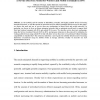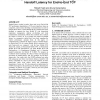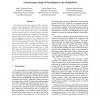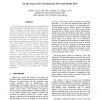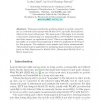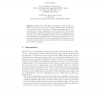IFIP
2003
Springer
14 years 4 months ago
2003
Springer
As the mobility and the number of affordable, powerful, and highly portable devices becoming networked increases, so will the amount of networked services offered, managed and disc...
MOBICOM
2003
ACM
14 years 4 months ago
2003
ACM
Handoff latency results in packet losses and severe End-to-End TCP performance degradation as TCP, perceiving these losses as congestion, causes source throttling or retransmissio...
LCN
2003
IEEE
14 years 4 months ago
2003
IEEE
We conducted a simulative evaluation of the overall performance of Fast Handovers for Mobile IPv6 in comparison with the baseline Mobile IPv6 using the network simulator ns-2 for ...
ISCC
2003
IEEE
14 years 4 months ago
2003
IEEE
Mobile IPv6 (MIPv6) and Fast Handover (FHO) have been developed by the Internet Engineering Task Force (IETF) to address the IP mobility issues of roaming mobile devices, and to r...
ISCC
2003
IEEE
14 years 4 months ago
2003
IEEE
As the Internet becomes pervasive, the vulnerability of some fundamental design aspects of the Internet has also become significant. Among which, Denial-of-Service (DoS) and Distr...
ISCC
2003
IEEE
14 years 4 months ago
2003
IEEE
Hierarchical Mobile IPv6 (HMIPv6) is a protocol that enhances Mobile IPv6 (MIPv6) with faster handovers. Neither HMIPv6 nor MIPv6 provides ways to authenticate roaming mobile node...
PAM
2005
Springer
14 years 5 months ago
2005
Springer
Abstract. This paper studies the problems related to mobile connectivity on a wireless environment with Mobile IPv6, specially the handover, which is the most critical part. The ma...
IPOM
2005
Springer
14 years 5 months ago
2005
Springer
Abstract. Fast Handovers is an enhancement to the Mobile IPv6 protocol, currently specified in an IETF draft, which reduces the handover latency. This can be beneficial to real-t...
ICOIN
2005
Springer
14 years 5 months ago
2005
Springer
Abstract. Mobile IPv6 is the IETF proposition to support host mobility in the Internet. It provides routing optimization for packets sent to the mobile node at the expense of signa...
CONEXT
2006
ACM
14 years 5 months ago
2006
ACM
While the IETF standardization process of the Mobile IPv6 and Network Mobility (NEMO) protocols is almost complete, their large-scale deployment is not yet possible. With these te...
